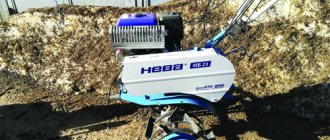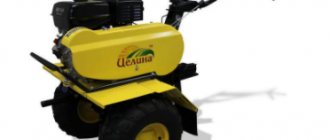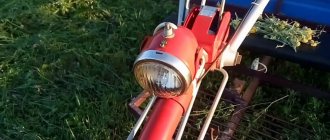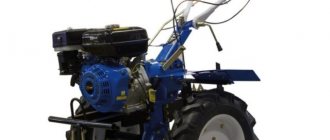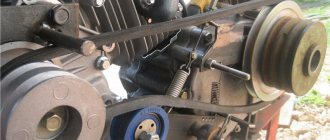Using various weighting agents for a walk-behind tractor, owners of land plots can significantly increase the functionality and expand the area of \u200b\u200bapplication of these machines. Motoblocks and motor cultivators are indispensable assistants in carrying out earthworks on large and small areas, transporting goods over short distances. With their help, less time and effort is spent on soil cultivation. However, in some cases, even the most modern and expensive equipment, such as the domestic Neva walk-behind tractor, cannot cope with individual tasks. When raising virgin soil, working on slopes and in damp ground, the wheels of the unit slip, as it does not have enough own weight for reliable grip. In order to make the machine heavier, various loads of factory and own production are used.
Since an agricultural equipment store can be located at a considerable distance from their summer cottage, many property owners make weighting devices on their own. Sometimes homemade weighting agents for a walk-behind tractor are installed in order to balance its center of gravity. This modification is required when landing or using an adapter. Consider how you can make weights on a walk-behind tractor with your own hands, using the tools and equipment that are at hand.
How to weight the cultivator with your own hands
Owners of small cultivators equipped with an electric motor (for example, the Garden M 750 ET, PATRIOT ELEKTRA 1000 or HYUNDAI T 1810E cultivator) are faced with such a problem that when passing through an area with hard or medium density soil, the mini cultivator bounces and cannot cope with the set task.
To make the manual plowing unit heavier, the craftsmen install foam blocks or a 5-liter bottle filled with sand on top of the body. Such an upgrade will help the mini-cultivator effectively process a small summer cottage, but it will become harder for the operator to manage it.
Features of use
The load for the walk-behind tractor increases the weight of the equipment, due to which the traction force increases. In this way, the machine can cultivate the soil more efficiently and deeply even in heavy soil types. Weights also improve the quality of work on hard ground, sloped areas.
Read also: Description of the Forza MK 80 walk-behind tractor
With the help of this additional equipment, the grip of walk-behind tractors with the soil is improved, and the balance of all attachments is achieved. It will be easier for the owner to manage the equipment and cultivate the land more efficiently.
How to weight the walk-behind tractor with your own hands
To eliminate slippage and increase the efficiency of light and medium-sized walk-behind tractors (such as: Neva MB-2 and MB-1, Patriot, Oka, Salyut and others), the installation of home-made weighting agents will help.
To figure out how to weight the walk-behind tractor correctly, you need to understand that there are three ways to achieve a specific task:
- fix loads on the body of agricultural machinery;
- make weights for wheels or lugs;
- increase the weight of the attachment (plow, hiller, blade-shovel for snow removal and others) to improve penetration.
Types of weights
Depending on the method of installation and design, such devices are conditionally divided into several types.
Weights for motoblock wheels
Most often, this type of cargo is used, it is mounted on brackets on the outside or inside of the wheels.
Frame weights on the body
They are used if you need to further increase the weight of the walk-behind tractor for tillage, they look like small loads or bars. Special designs are fixed on the frame of the equipment with bolts and in such a way that they do not come into contact with moving parts of the equipment.
Motoblock weights for lugs
These devices are needed if traction gain is to be increased. Thanks to this, the equipment will not slip under high load.
When choosing weights on the wheels of a walk-behind tractor or on its body, you should pay attention to the following characteristics:
- width of additional equipment;
- diameter of structures (for mounting on wheels);
- cargo weight (starts from 20 kg and on average can increase the tractive effort of the walk-behind tractor by 20%).
List of tools and equipment
As a rule, each suburban area has a sufficient number of metal products and a set of devices for a wide range of work.
In order to make wheel weights for a walk-behind tractor with your own hands, you will need the following tools and materials:
- roulette;
- welding machine;
- building level;
- grinder with discs for cutting and grinding metal;
- electric drill with a set of drills;
- a small steel or aluminum barrel with a screw cap;
- pancakes from a barbell weighing 5, 10, 20 kg;
- steel corner 30-50 mm;
- paint brush;
- car paint.
Weight the walk-behind tractor so that it is always possible to quickly dismantle the attached devices. They will not be required when mowing grass and performing other work that does not require strong adhesion to the ground. Excess cargo in such cases will interfere and lead to excessive fuel consumption.
How to make your own weights
To make weights for the wheels of a walk-behind tractor, there is enough desire, a minimum of material and time. There are no particular difficulties. You need to prepare the future details of this device:
- 2 five-kilogram weights;
- 2 ten-kilogram pancakes;
- 2 clutch baskets from Zhiguli;
- hexagonal solid profile (piece);
- motoblock cotter pins (2 pcs.).
All this can be left lying around at the collection point for old scrap. You can not do without a welding machine with electrodes, a grinder with a cutting wheel, drills with drills. Well, to give an aesthetic appearance to the device, you should stock up on paint.
Manufacturing:
2 pieces are cut from the hexagonal profile, about 5 cm in size. Holes for the cotter pins will need to be drilled in them. Then this segment is attached to the pancake from the bar. The hexagon is inserted into the hole from the fingerboard and welded.
Then you will need to attach the clutch basket to the pancake. For this, welding is used - it is scalded around the circumference of the flywheel. After that, you need to attach a weight to the clutch. Now it remains to paint everything and let the paint dry.
The same is done in order to make a weighting agent for another wheel. As a result, the walk-behind tractor will become 50 kg heavier.
The inner hole of the walk-behind tractor axle can accommodate a hexagonal mount, so the weights made can be easily attached there. To mount the sinkers, a hole for the cotter pin is drilled in the axle. Now the weights are ready to be installed on the wheel. The cotter pin will not fall out if it is secured with steel wire.
If there are few wheel weights, then you can add weight to the body of the walk-behind tractor.
To do this, cook the frame, attach it to the frame of the walk-behind tractor. You can find a pancake that weighs at least 25 kg, weld it and secure it with a bolt. An important condition is to cut a hole in the frame so that you can drain the oil from the engine. Such a design can be welded from an angle profile and have the shape of a box.
Do-it-yourself load on the wheels of a walk-behind tractor
The most common way to weight the car is to install additional weights on the wheels. The rims, axle and hub are strong enough to support up to 50 kg of added weight. You can make weights for the Neva, Ugra, Cascade, Rusich, Nadezhda, Forza, Salute, Mole motoblock in various ways.
The first method is to manufacture cargo from hollow steel drums.
This is the simplest and most affordable option that does not require serious financial costs.
The work is carried out in the following sequence:
- A metal barrel is cut by a grinder into 3 parts (the bottom and top should be 10-15 cm high - depending on the size of the walk-behind tractor).
- The bottom and top parts are welded at the place of the cut. The seam can be reinforced with a strip of metal.
- 4-6 through holes for bolts are drilled in the workpiece, if necessary, they are reinforced with steel washers.
- Hollow tanks are fastened to wheel rims with long bolts and nuts.
- Sand and granite chips or other bulk material are poured inside the nozzles. Water is added to increase its density.
- The lid is screwed on.
This weighted unit can be used in the most extreme conditions. When the need for additional cargo disappears, it can be quickly removed, emptied and stored. It is advisable to always have pads with the walk-behind tractor in order to quickly make it heavier when the need arises.
The second method is the manufacture of removable steel weights. To do this, you need a hexagonal iron rod, the size of which matches the hole in the axle of the chassis of the unit. Additionally, you need to have 2 20-kilogram pancakes from the barbell.
The subsequent work consists of the following steps:
- 2 pieces of 5-6 cm long are cut off from the profile.
- Profile pieces are welded to the discs at the neck hole.
- Through holes for cotter pins are made in the axis of the unit and in the profile.
- The made weighting agents cling to the walk-behind tractor and are fixed with cotter pins.
If there is a need for an additional increase in the mass of the wheel, then 10-kilogram pancakes from the bar can be welded to the lining. To give the wheel an aesthetic look, old VAZ clutch baskets are welded to the loads. Paint is applied over the basket, the color of which suits the owner the most.
The third way to weight the wheels is to make an additional load of reinforced concrete. These loads are made in this way:
- A flask is made of sand or gypsum, its walls and bottom are strengthened with cement mortar or liquid glass.
- A three-dimensional frame is made from a sheet of steel and reinforcement, the center of which is a solid hexagon with a pre-drilled hole for a cotter pin.
- Heavy concrete is made using fine crushed granite and lead filler.
- The solution is poured into the mold, carefully compacted and leveled.
- After the concrete has gained strength, its surface is impregnated and painted.
For additional weighting of concrete nozzles, it is recommended to leave threaded inserts.
In addition to the listed manufacturing methods, loads on a walk-behind tractor are made from:
- cement balancers from a washing machine;
- lead, by casting the desired shape;
- steel sheet and sand.
The last option is better to do not with native motor-block pneumatic wheels, but take a couple of automobile ones (for example, from Zhiguli), and upgrade them. To do this, it is necessary to weld hubs from the old wheels of the cultivator to them, and attach steel sheets to the sidewalls by welding. Sand is poured into the resulting cavity or a cement mixture is poured.
Types of weights
Weighting agents are:
- disk - used mainly for wheels;
- lamellar - for other parts of the walk-behind tractor.
for wheels
Disc weights for motoblock wheels are mounted on discs, as the name implies. They are thick metal rings with a hole in the middle. In cases of emergency, they can also be made of concrete.
You can fix them in two ways. The easiest option is to weld. It is suitable in cases where the equipment is constantly used on heavy soils, and there is no need to take it to the city at the end of the season. In this case, it is quite possible to install non-removable welded weights.
Must Read: Excavator Backhoe
In other cases, it will be more convenient and practical to fix the loads with bolts. Weighting agents are not needed when mowing grass, transporting goods on a flat road and other light work. Removable weights will provide free weight adjustment depending on the conditions and, if necessary, will facilitate the transportation of the walk-behind tractor.
It is important to remember that the total weight of wheel loads should not exceed 50 kg. Overloading will lead to increased wear on the axles and hubs. The exact load level for a particular model is recommended to be checked with the seller.
On the body
If the farmer is faced with the question of not only how to weight the walk-behind tractor, but also how to improve the weight distribution, you should pay attention to plate loads. They are metal bars, attached to the body. Can be used in combination with wheeled ones. As in the case of wheel weights, they can be removable or non-removable. It is recommended to give preference to threaded connections.
Wheel weights
For lugs
Grouser weights are installed similarly to wheel weights. The fastening depends on the design of the lugs: they can be installed with the removal of the main wheels or mounted on top. Some farmers simply fill the center of the grouser with concrete, but where possible, more gentle and technical options should be preferred.
How to weight lugs to a walk-behind tractor
To perform work on viscous clay or loamy soil, metal lugs are installed on the walk-behind tractor instead of wheels. In order to maintain the required plowing depth, it is necessary to weight the machine by hanging loads on the running gear of the unit.
If factory weights act as loads and their weight is not enough, auxiliary weights can be used together with them. Make weights yourself:
- upgrade lugs by welding metal pancakes;
- make concrete weights (the procedure here is similar to the method of making weights for pneumatic wheels, only as a mold for casting it is necessary to take a pan with straight walls and a flat bottom, or a cut metal barrel of a suitable diameter);
- flywheels from the VAZ 2106 Zhiguli car engine are well suited as a load, one for each wheel;
- pick up pulleys from agricultural machinery for disassembly, suitable in diameter.
Weighting of the body of the walk-behind tractor
In some cases, the mass of wheel weights is not enough. Since it is not recommended to overload the axle, weight is added to the body of the unit. This can be done in different ways. The best option is to fix the removable steel frame directly on the walk-behind tractor. The basis can be a frame, a gearbox or a niche for installing a battery.
The increase in the mass of the body is carried out in the following sequence:
- Determination of the center of gravity of the unit. Create a wireframe project.
- Welding to the casing of the gearbox, and to the steering wheel bracket of the walk-behind tractor - bolts with a diameter of 12 mm and a length of at least 10 cm.
- Welding the frame from the corner. Making mounting holes in it for bolts.
- Frame fit on frame. Drilling holes in it corresponding to the location of the holes on the frame.
- Cleaning the frame from dirt and rust. Painting the product and fixing it on the frame.
- Production of cargo according to the size of the frame. You can find the necessary parts at the scrap metal collection point, where the material will be immediately cut into fragments of the desired size.
The fastening of the weights on the walk-behind tractor is carried out by welding or bolting. The second option is longer in implementation, but more practical in the long run. The need to remove additional weight arises when transporting the unit or performing light work, when excessive pressure on the ground is contraindicated.
How to make a counterweight on a walk-behind tractor with your own hands
A counterweight is a front weighting agent for a walk-behind tractor, which is hung on the front bumper pipe and helps to increase the efficiency of plowing hard soil and virgin lands. And also with its help, you can shift the center of gravity of the cultivator, thereby increasing stability during operation.
To make a counterweight on a walk-behind tractor with your own hands, you will need heavy improvised items, fasteners and a little ingenuity. Consider several homemade options:
- five-liter bottles filled with water or sand, which are hung by the handle and fastened with a carabiner;
- a counterweight from a weight for scales (under it it is necessary to make a frame from a metal tape, which will be inserted into the guides from a steel profile welded from below to the frame of the agricultural unit);
- a weighting agent cast from lead or cement in the form of a parallelepiped or cylinder, with pre-inserted "ears" of a steel rod for hanging;
- several pancakes fastened together, to the extreme of which metal carbines are welded, which serve as clamps for a home-made device.
How to install weights
When plowing, loads are placed on the front drawbar. When milling - between the steering wheel bracket and the gearbox so that the walk-behind tractor stands level, without leaning forward or backward. Before that, you should determine the center of gravity and make sure that it shifts as low as possible.
The total weight of the goods should not exceed 100 kg, and the continuous operation time should not exceed 1 hour. Exceeding the load will lead to premature wear of the transmission and permanent overload of the motor.
Be sure to read: How to convert megapascals to kilopascals

